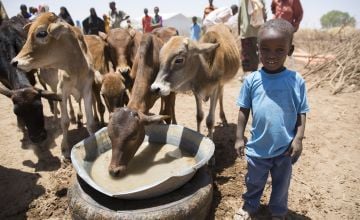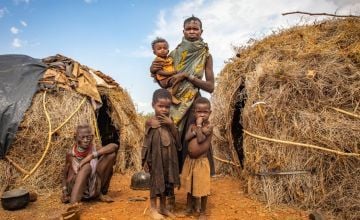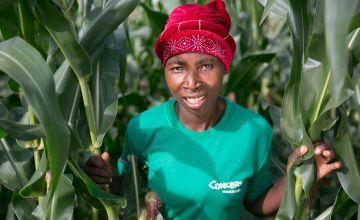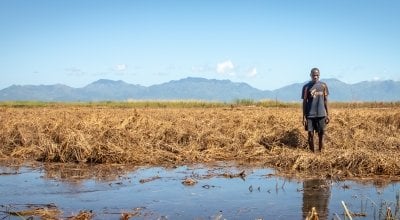
Read our 2023 annual report

Knowledge Hub
Since the early 1990s, the number of extreme weather-related disasters has doubled. Harvests have decreased, and food prices have risen as a result. The climate crisis is fueling the hunger crisis, and with our food systems more global than ever, we all stand to lose.
Sadly, this is not a trend that appears to be going away any time soon. Looking ahead, climate models predict higher average temperatures around the world and hotter extremes, rising sea levels in coastal areas and more frequent droughts in other areas. The Horn of Africa is currently experiencing its worst drought in 40 years.
While climate change can be a difficult topic to fully understand, the human impacts are clear and very tangible: Millions of people go to bed hungry every night as a result of global warming. Here are four ways that climate change and hunger go hand-in-hand — and why we should all be concerned.
1. Climate change impacts agriculture and food production
Higher temperatures, water scarcity, droughts, floods, and greater CO2 concentrations in the atmosphere affect staple crops around the world. Corn and wheat production has declined in recent years due to extreme weather events, plant diseases, and a global water crisis.
According to the Food and Agriculture Organisation, 80% of the causes behind an unpredictable harvest for cereal crops in areas like Africa’s Sahel come down to climate variability. In other areas like Bangladesh and Vietnam, rising sea levels pose a different threat to food security. There, coastal farmlands are often flooded by saltwater, which kills off rice crops. With half of Vietnam’s national rice production centred in the Mekong Delta, even a minor flood can have major implications.
While the causes of these issues are fairly consistent, the solutions are not. This means that, with the effects of climate change already apparent in areas like the Horn of Africa and Southeast Asia, we need to find unique methods to mitigate disasters when they strike, and develop bespoke ways to reduce the impacts of hazards on the lives and livelihoods of these areas in the future.

2. Climate change limits access to food
If climate change reduces the amount of food produced, then it makes sense that it also reduces the amount of food people can access. This simple instance of supply-and-demand, however, has big impacts. If one part of the food system is interrupted due to a climate event (big or small), that can lead to inflation. We’ve seen this happen over the last two years after international trade was suspended due to COVID-19. These price spikes leave the poorest families most vulnerable; one study shows that people living in urban areas under the poverty line spend up to 75% of their budget on food alone.
Many of the world’s hungriest countries rely on agriculture as their main industry, which means that families eat seasonally in keeping with what their harvests (and their neighbours’ harvests) bring in. In the times before harvest known as “hungry seasons,” when the previous supply of food has been used up and the next crops are not quite ready to pick, families often skip one or more meals per day. In many areas, climate change has prolonged these hungry seasons.

3. Climate change decreases the nutritional value of food
Hunger and malnutrition are issues of both quantity and quality. Climate change affects both. Studies show that higher concentrations of carbon dioxide in plants reduce their protein, zinc, and iron content. By 2050, an estimated 175 million people could develop zinc deficiencies. 122 million people may be protein-deficient by that time as well.
Beyond plant-based nutrition, climate change also affects the quality of livestock, which rely on the same resources as humans to eat, grow, and produce meat, eggs, and/or milk. Cattle, goats and other livestock account for 36% of all drought-related losses (crops make up 49%). Likewise, climate extremes threaten fish populations, especially in areas like Southeast Asia.
4. Climate change increases food waste
Even if a harvest is good (or promises to be good), more of it now goes to waste as the climate crisis intensifies. Crops grown in high-drought areas are often moved into humid storage facilities, leaving them vulnerable to fungal infestations and pests. Rain doesn’t always help, either: Flooding from extreme rainfalls can also produce toxic mould on crops. The more the climate changes and the more that extreme climate events become commonplace, the more food we lose on an annual basis.
According to the UN’s Food and Agriculture Organisation, roughly one-third of the food produced by farmers is lost between the field and the market in low- and middle-income countries. In high-income countries, a similar amount is wasted between the market and the table. Currently, the food system contributes 21–37% of greenhouse gases, meaning that these food losses add to the climate crisis but do nothing for food security or malnutrition levels.

Climate change and hunger: What comes next?
Climate change affects the global food system in such a way that those who already suffer from hunger and undernutrition are those most vulnerable to losing more as the climate crisis continues. In order to end hunger — one of our top Sustainable Development Goals for the year 2030 — we need to address the causes of climate change, particularly at the governmental and policy levels. We also need to prioritise climate justice to support the communities on the frontlines of the crisis, communities that often contribute very little to greenhouse gas emissions.
The last few years have made it clear that this cannot happen in isolation. We must foster global solidarity with the most climate-vulnerable communities and countries. High-income countries (especially those with the highest greenhouse emissions) must take responsibility for both mitigating the causes of climate change and supporting low- and middle-income countries in adapting to the effects of these changes. We must also honour commitments to programmes like the Paris Climate Agreement, and accelerate national and international responses.
All of this is a tall order, but it’s an order that will affect all of our futures, regardless of where we live.

Climate change and hunger: Concern’s response
Concern is clear that the climate crisis constitutes the most serious global environmental threat and is a significant poverty and hunger multiplier.
The majority of people Concern works with are involved in some way with farming and food production. Many of these communities are also on the frontlines of climate change. We work with rural communities to promote Climate Smart Agriculture, an approach that helps families adapt to better crops, growing techniques, and soil improvement practices in response to the changing and often unpredictable environment. We also work to strengthen links with the private sector to facilitate access to supplies and equipment.
We combine this with our award-winning and standard-setting programme, Community Management of Acute Malnutrition (CMAM), which has saved millions of lives over the past 20 years. We’ve continued to work with partners and communities to find more tailored approaches to community-based treatment of childhood malnutrition, which has led to CMAM Surge: a way of proactively responding to malnutrition during seasonal “surge” periods throughout the year. Two CMAM Surge pilot tests in Kenya in 2012 saw that the model managed peaks, without undermining other health and nutrition efforts.




